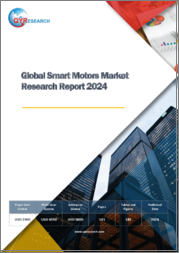
|
시장보고서
상품코드
1516356
스마트 모터 시장 : 전압별, 산업별 - 예측(2024-2032년)Smart Motor Market - By Voltage (Upto 18V, 19V-24V, 25V-36V, 48V & Above), By Industry Verticals (Industrial, Automotive, Aerospace & Defense, Energy & Utilities, Consumer Electronics, Healthcare) & Forecast, 2024 - 2032 |
||||||
스마트 모터 시장 규모는 에너지 효율과 지속가능성에 대한 관심으로 2024년부터 2032년까지 연평균 6.5% 이상 성장할 것으로 전망됩니다.
SE for All에 따르면, SDG7.3은 2030년까지 전 세계 에너지 효율 개선률을 두 배로 늘리는 것을 목표로 하고 있습니다. 전 세계적으로 환경 문제에 대한 인식이 높아지고 탄소 배출량을 줄여야 할 필요성이 커지면서 산업계는 에너지 효율이 높은 솔루션을 채택하는 것을 우선순위로 삼고 있습니다. 크루즈 컨트롤, 지능형 제어 시스템 등 첨단 기술이 탑재된 지능형 엔진은 기존 엔진에 비해 에너지 효율을 크게 향상시킵니다. 에너지 사용을 최적화하고 낭비를 최소화함으로써 스마트 모터는 기업의 운영 비용 절감에 기여할 뿐만 아니라 탄소 발자국을 줄임으로써 지속가능성 목표에도 기여할 수 있습니다.
중요한 시장 트렌드는 전문 기능의 아웃소싱으로의 전환입니다. 기업들은 스마트 엔진 배치 및 유지보수 관련 업무의 일부를 아웃소싱하기로 결정하고 있습니다. 이러한 전략적 전환을 통해 기업은 핵심 비즈니스에 집중하면서 전문성, 확장성 및 비용 효율성을 활용할 수 있습니다. 또한, 전문 업무의 아웃소싱은 진화하는 규제와 표준을 준수하고, 위험을 줄이며, 업무의 효율성을 높일 수 있습니다. 스마트 모터 기술이 고도화됨에 따라 아웃소싱 트렌드는 더욱 확대되어 시장의 성장과 혁신을 촉진할 것으로 보입니다.
스마트 모터 산업은 전압, 산업 및 지역에 따라 분류됩니다.
25V-36V급 부문은 2032년까지 계속 성장할 것으로 예상됩니다. 이 전압 범위에서 작동하는 스마트 모터는 전력과 정밀도의 균형 잡힌 조합을 제공하여 다양한 산업 분야의 다양한 용도에 적합하기 때문입니다. 소형 기계에서 중형 산업 장비에 이르기까지 지능형 25V-36V 모터는 에너지 소비와 운영 비용을 줄이면서 최적의 성능을 보장합니다. 에너지 효율과 지속가능성을 우선시하는 산업에서 이 전압 부문은 스마트 모터에 대한 수요가 크게 증가하여 자동화 및 산업 공정을 촉진할 것으로 예상됩니다.
에너지 및 유틸리티 부문은 스마트 모터가 효율성, 신뢰성, 지속가능성을 향상시키는 데 도움이 되기 때문에 2032년까지 빠르게 성장할 것으로 예상됩니다. 이 모터는 펌프, 압축기, 팬, 에너지 생산 및 분배에 필수적인 전기 인프라 및 공정 등 다양한 분야에서 사용되고 있습니다. 스마트 모터는 첨단 센서 기술과 예측 분석을 통해 예측 유지보수를 가능하게 하고, 다운타임을 줄이며, 에너지 소비를 최적화할 수 있습니다. 또한, 스마트 그리드 기술의 통합은 에너지 분배 시스템의 효율성을 더욱 향상시켜 비용 절감과 환경적 지속가능성으로 이어집니다.
유럽의 스마트 모터 산업은 엄격한 규제, 에너지 효율에 대한 노력, 기술 발전으로 인해 2032년까지 전례 없는 속도로 확장될 것입니다. 독일, 프랑스, 영국과 같은 국가들은 이러한 디지털 혁신의 최전선에서 제조업과 산업 부문의 현대화를 주도하고 있습니다. 지속가능성과 혁신을 중시하는 유럽 산업계는 경쟁력 향상과 환경적 부담을 줄이기 위해 지능형 엔진 솔루션으로의 전환을 가속화하고 있습니다. 또한, 정부의 인센티브 및 자금 지원 프로그램도 스마트 모터 기술 채택을 지속적으로 장려하고 있어 시장 성장에 유리한 환경을 조성하고 있습니다.
목차
제1장 조사 방법과 조사 범위
제2장 주요 요약
제3장 업계 인사이트
- 생태계 분석
- 벤더 매트릭스
- 이익률 분석
- 기술 및 혁신 전망
- 특허 분석
- 주요 뉴스와 이니셔티브
- 규제 상황
- 영향요인
- 성장 촉진요인
- 업계의 잠재적 리스크&과제
- 성장 가능성 분석
- Porter's Five Forces 분석
- PESTEL 분석
제4장 경쟁 구도
- 서론
- 기업 점유율 분석
- 경쟁 포지셔닝 매트릭스
- 전략 전망 매트릭스
제5장 시장 추산·예측 : 전압별, 2018-2032년
- 주요 동향
- 18V 미만
- 19V-24V
- 25V-36V
- 48V 이상
제6장 시장 추산·예측 : 업계별, 2018-2032년
- 주요 동향
- 산업
- 자동차
- 항공우주 및 방위
- 에너지 및 유틸리티
- 가전
- 헬스케어
- 기타
제7장 시장 추산·예측 : 지역별, 2018-2032년
- 주요 동향
- 북미
- 미국
- 캐나다
- 유럽
- 영국
- 독일
- 프랑스
- 이탈리아
- 스페인
- 기타 유럽
- 아시아태평양
- 중국
- 인도
- 일본
- 한국
- 뉴질랜드
- 기타 아시아태평양
- 라틴아메리카
- 브라질
- 멕시코
- 기타 라틴아메리카
- 중동 및 아프리카
- 아랍에미리트(UAE)
- 남아프리카공화국
- 사우디아라비아
- 기타 중동 및 아프리카
제8장 기업 개요
- ABB Ltd.
- Dunkermotoren GmbH(Ametek Inc.)
- Fuji Electric Co. Ltd
- General Electric
- Moog Inc.
- Nanotec Electronic GmbH & Co. KG
- Nidec Motion Control(Nidec Corporation)
- RobotShop, Inc.
- Rockwell Automation
- Safran Electrical & Power
- Schneider Electric SE
- Shanghai Moons'Electric Co. Ltd
- Siemens AG
- Technosoft SA
- Turntide Technologies Inc.
Smart motors market size will grow at over 6.5% CAGR from 2024 to 2032 due to an emphasis on energy efficiency and sustainability. According to SE for All, SDG 7.3 aims to double the global rate of improvement in energy efficiency by 2030. As awareness of environmental issues grows worldwide and the need to reduce carbon dioxide emissions, industries are prioritizing the adoption of energy-efficient solutions. Equipped with advanced technologies such as cruise control and intelligent control systems, intelligent engines offer significant improvements in energy efficiency compared to conventional engines. By optimizing energy use and minimizing waste, smart motors not only help businesses reduce operating costs but also contribute to sustainability goals by reducing their carbon footprint.
A significant market trend is the shift to outsourcing specialized functions. Companies have decided to outsource some tasks related to the deployment and maintenance of smart engines. This strategic shift allows companies to leverage expertise, scalability, and cost efficiency while focusing on their core business. Outsourcing specialized functions also ensures compliance with evolving regulations and standards, reduces risks, and makes operations more efficient. As the sophistication of smart motor technologies increases, the outsourcing trend will grow further, driving market growth and innovation.
The Smart Motor industry is classified based on voltage, industry, and region.
The 25V-36V class segment will continue to grow through 2032, as smart motors operating in this voltage range offer a balanced combination of power and precision, making them ideal for various applications in various industries. From small machines to medium-duty industrial equipment, intelligent 25V to 36V motors ensure optimal performance while reducing energy consumption and running costs. As the industry prioritizes energy efficiency and sustainability, the demand for smart motors is expected to grow strongly in this voltage segment, which will drive automation and industrial processes.
The energy and utilities segment will grow rapidly through 2032 as smart motors help improve efficiency, reliability, and sustainability. These motors are used in many applications, including pumps, compressors, and fans, and electrical infrastructure and processes essential for energy production and distribution. Using advanced sensor technology and predictive analytics, smart motors enable predictive maintenance, reduce downtime, and optimize energy consumption. In addition, the integration of smart grid technologies further improves the efficiency of energy distribution systems, leading to cost savings and environmental sustainability.
Europe Smart Motor industry will expand at an unprecedented rate through 2032 due to strict regulations, energy efficiency initiatives, and technological advances. Countries like Germany, France, and the UK are at the forefront of this digital transformation and are leading the way in modernizing their manufacturing and industrial sectors. With an emphasis on sustainability and innovation, European industry is increasingly moving towards intelligent engine solutions to improve its competitiveness and reduce environmental impact. In addition, government incentives and funding programs continue to encourage the adoption of smart motor technology, creating a favorable environment for market growth.
Table of Contents
Chapter 1 Methodology & Scope
- 1.1 Market scope & definition
- 1.2 Base estimates & calculations
- 1.3 Forecast calculation
- 1.4 Data sources
- 1.4.1 Primary
- 1.4.2 Secondary
- 1.4.2.1 Paid sources
- 1.4.2.2 Public sources
Chapter 2 Executive Summary
- 2.1 Smart motor industry 360 degree synopsis, 2018 - 2032
- 2.2 Business trends
- 2.2.1 Total addressable market (TAM), 2024-2032
Chapter 3 Industry Insights
- 3.1 Industry ecosystem analysis
- 3.2 Vendor matrix
- 3.3 Profit margin analysis
- 3.4 Technology & innovation landscape
- 3.5 Patent analysis
- 3.6 Key news and initiatives
- 3.7 Regulatory landscape
- 3.8 Impact forces
- 3.8.1 Growth drivers
- 3.8.1.1 Increasing focus on reducing operational costs
- 3.8.1.2 Demand for compact, high-performance motor solutions
- 3.8.1.3 Emphasis on sustainability and green technologies
- 3.8.1.4 Advancements in sensor technology for motor monitoring
- 3.8.1.5 Growth in automotive electrification and smart mobility
- 3.8.2 Industry pitfalls & challenges
- 3.8.2.1 Complexity of integrating new systems with existing infrastructure
- 3.8.2.2 Challenges in retrofitting older equipment with smart technology
- 3.8.1 Growth drivers
- 3.9 Growth potential analysis
- 3.10 Porter's analysis
- 3.10.1 Supplier power
- 3.10.2 Buyer power
- 3.10.3 Threat of new entrants
- 3.10.4 Threat of substitutes
- 3.10.5 Industry rivalry
- 3.11 PESTEL analysis
Chapter 4 Competitive Landscape, 2023
- 4.1 Introduction
- 4.2 Company market share analysis
- 4.3 Competitive positioning matrix
- 4.4 Strategic outlook matrix
Chapter 5 Market Estimates & Forecast, By Voltage, 2018 - 2032 (USD Billion)
- 5.1 Key trends
- 5.2 Upto-18V
- 5.3 19V-24V
- 5.4 25V-36V
- 5.5 48V & above
Chapter 6 Market Estimates & Forecast, By Industry Verticals, 2018 - 2032 (USD Billion)
- 6.1 Key trends
- 6.2 Industrial
- 6.3 Automotive
- 6.4 Aerospace & defense
- 6.5 Energy & utilities
- 6.6 Consumer electronics
- 6.7 Healthcare
- 6.8 Others
Chapter 7 Market Estimates & Forecast, By Region, 2018 - 2032 (USD Billion)
- 7.1 Key trends
- 7.2 North America
- 7.2.1 U.S.
- 7.2.2 Canada
- 7.3 Europe
- 7.3.1 UK
- 7.3.2 Germany
- 7.3.3 France
- 7.3.4 Italy
- 7.3.5 Spain
- 7.3.6 Rest of Europe
- 7.4 Asia Pacific
- 7.4.1 China
- 7.4.2 India
- 7.4.3 Japan
- 7.4.4 South Korea
- 7.4.5 ANZ
- 7.4.6 Rest of Asia Pacific
- 7.5 Latin America
- 7.5.1 Brazil
- 7.5.2 Mexico
- 7.5.3 Rest of Latin America
- 7.6 MEA
- 7.6.1 UAE
- 7.6.2 South Africa
- 7.6.3 Saudi Arabia
- 7.6.4 Rest of MEA
Chapter 8 Company Profiles
- 8.1 ABB Ltd.
- 8.2 Dunkermotoren GmbH (Ametek Inc.)
- 8.3 Fuji Electric Co. Ltd
- 8.4 General Electric
- 8.5 Moog Inc.
- 8.6 Nanotec Electronic GmbH & Co. KG
- 8.7 Nidec Motion Control (Nidec Corporation)
- 8.8 RobotShop, Inc.
- 8.9 Rockwell Automation
- 8.10 Safran Electrical & Power
- 8.11 Schneider Electric SE
- 8.12 Shanghai Moons' Electric Co. Ltd
- 8.13 Siemens AG
- 8.14 Technosoft SA
- 8.15 Turntide Technologies Inc.



















